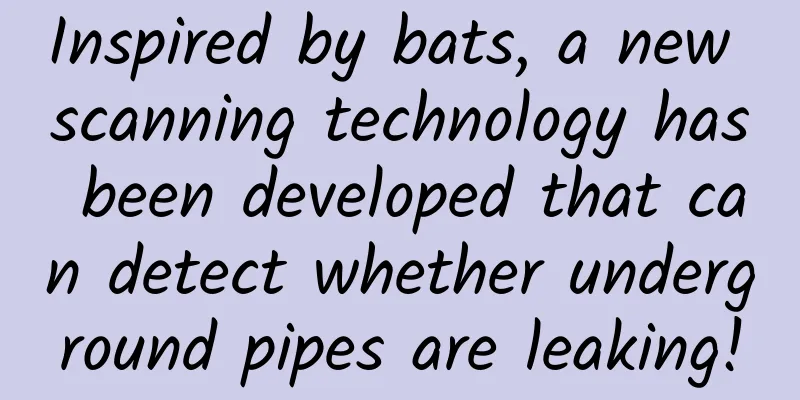Inspired by bats, a new scanning technology has been developed that can detect whether underground pipes are leaking!

|
Engineers have developed a new scanning technology inspired by nature that can detect corroded metal in oil and gas pipelines. By mimicking how bats use different wavelengths of ultrasound to detect objects, hunt and avoid predators, engineers have developed a new system that combines two different types of radiation, fast neutrons and gamma rays, to detect corrosion - the leading cause of pipeline leaks. With thousands of kilometers of pipelines used around the world to transport oil and gas over long distances, leaks are a major problem that costs millions of dollars each year. And it has the potential to cause accidents and loss of life, as well as significant environmental damage. Typically, corrosion in oil pipelines is measured using ultrasonic or electromagnetic techniques. However, these methods do not work for underground pipes or pipes covered with concrete or plastic insulation. The new system, developed by engineers at Lancaster University, the National Physical Laboratory and a company called Hybrid Instruments Ltd, exploits the reflected signal known as backscatter, which is an "isolated combination of fast neutrons and gamma radiation" because neutrons and gamma rays have useful complementary properties, and neutrons mainly interact with low-density materials such as plastics. In addition, fast neutrons have a higher penetrating power, making them suitable for probing thick materials. Gamma rays interact mainly with metals and are not always able to penetrate very thick materials with a high density. The two radiation types produce different electronic signatures, which means that the researchers can retain data from both radiation types simultaneously using a new type of detection device called a 'hybrid field analyser', which was previously developed by Lancaster University and Hybrid Instruments Ltd. The system produces a pencil-like beam of probing radiation, consisting of neutrons and gamma rays, which is pointed at the section of steel being inspected. The team tested the real-time imaging technique in the lab on samples of carbon steel of varying thicknesses. The researchers were able to see differences in the thickness of the steel, and the sensor also worked when the insulation was replicated with concrete or plastic, suggesting that defects in the steel as well as corrosion and rust could create variations in backscatter. These results suggest that if used on real pipelines, potential problems could be more easily spotted and fixed before oil and gas are able to leak out. Mauro Licata, a PhD researcher at Lancaster University who worked on the project, said: The combined beams of neutrons and gamma rays bounce in parallel onto an array of detectors, producing a comprehensive and rapid representation of the steel's internal structure. The system works a bit like the ultrasound waves emitted by a bat. These are a superposition of different ultrasound wavelengths that bounce back into the bat's ears. As well as highlighting the benefits of combining multiple reflectance sensing techniques to detect problems such as corrosion, the research further demonstrates that there is huge potential in taking inspiration from and imitating systems that have evolved in nature. Professor Malcolm Joyce of Lancaster University and Hybrid Instruments Ltd said: Real-time isolation of backscattered neutrons and gamma rays from the steel surface, in the same way a bat's brain isolates backscattered ultrasound waves so they are not confused with their own, could help us isolate defects in pipe walls more quickly and efficiently. Neil Roberts, of the National Physical Laboratory, said: "This is a great example of NPL's world-leading neutron facilities being used to innovate science and have a positive impact. The aim is to further develop and use the detector system to detect faults by pointing it at sections of pipe from the outside. However, the researchers said more research is needed in the field of neutron detectors to make the system even faster. Bokeyuan|www.bokeyuan.net Bo Ke Yuan | Research/From: Lancaster University Reference journal: Scientific Reports DOI: 10.1038/s41598-020-58122 BoKeYuan|Science, technology, research, popular science Follow [Bokeyuan] to see more beautiful cosmic science |
Recommend
6 marketing strategies of Heytea and Nayuki
It is undeniable that "milk tea" is the...
[Daiyu Finance] Pantaoyuan Swallow Returns Strategy Swallow Style Strategy Third Style Returning Slowly on the Road
[Daiyu Finance] Pantaoyuan Swallow Returning Stra...
How to do knowledge marketing by Baidu promotion? Cases and optimization ideas
Now is the end of the year, and Baidu's resou...
Nature News: What makes paralyzed people walk again? Scientists have made a new discovery
Paralysis refers to the reduction or loss of volu...
China's first ship! About to be launched!
There is such a "city on the sea" with ...
The World Cup is coming, brands trying to take advantage of the hype need to avoid these pitfalls!
The World Cup, which is held every four years, is...
With the same 4GB of memory, why can the iPhone be used smoothly for 5 years, but Android cannot?
Looking back at some of my friends around me, unt...
Douyin promotion method: 6 types of content that Douyin limits traffic!
On April 14, Douyin's e-commerce assistant is...
Fission Methodology | How to achieve precise fission and improve paid conversions?
Last week, I helped a friend implement a project....
Samsung S5's powerful fingerprint function sharing
Samsung's new flagship GALAXY S5 has brought g...
TSMC has manufactured over 1 billion 7nm chips (with original text)
Recently, TSMC announced on its official blog tha...
The golden arowana and axolotl commonly seen in the aquarium market are actually protected animals.
The beautiful bony tongue fish in the picture has...
A Chinese dung beetle can be sold for less than two dollars in Australia? Because dung beetles are also picky eaters
An initial population of 1,500 Chinese dung beetl...
Today in Science and Technology History | 1997·9·25 Chinese scholars solved the mystery of "Shangri-La"
In 1933, British writer James Hilton described in...







![[Smart Farmers] "Chinese Tea" has been successfully listed as a World Heritage Site. Here are some things you need to know](/upload/images/67f24b007c2b5.webp)

